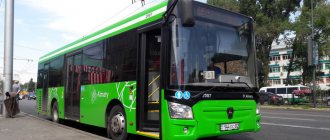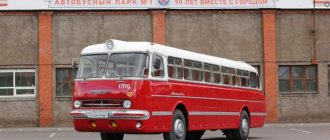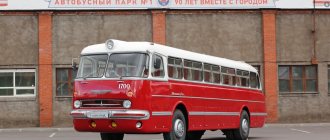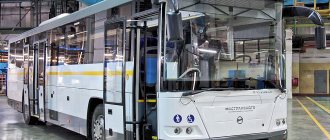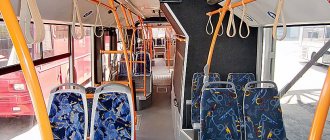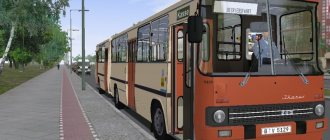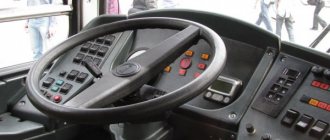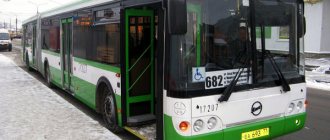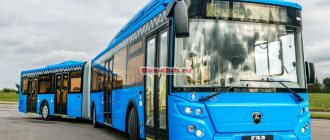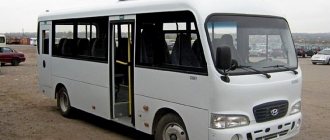City articulated bus LiAZ-6212. Photo Wikipedia
LiAZ-6212 is a Russian high-floor city bus of an especially large class produced by the Likinsky Bus Plant. The first mass-produced articulated bus designed in Russia. It is an articulated analogue of the LiAZ-5256 bus. A prototype was produced in 2002. Serial production - since 2003.
History of creation
The bus was created on the basis of the LiAZ-5256 model, the first samples of which, the SVARZ-6240 and YaAZ-6211 , were assembled back in 1993 and 1996, respectively. The engines in these cars were located horizontally under the cabin floor. The model with the rear engine LiAZ-6220 did not go into production.
The new bus received an index - LiAZ-6212.00 . Caterpillar-3126 diesel engine with a power of 300 hp. With. The factory numbering of new cars started again from one, i.e. the car from the mid-90s was not taken into account in the new numbering. Thus, 2 experimental yellow-gray buses received serial numbers 1 and 2 (the last of them was presented at the Moscow Motor Show at Krasnaya Presnya in 2002).
City bus LiAZ-6212 with increased capacity. Photo Wikipedia
The two experimental buses had a standard appearance (like most LiAZ-5256), but the cabin was a little non-standard: the arrangement of control devices and instruments was somewhat different, and the partition was only directly behind the driver. But such an exterior and interior were not destined to go into production - all subsequent cars had plastic trim on the front and rear, under which square headlights were hidden. The cabin has also changed : a narrow partition has appeared, and instead of a window for communication with the driver, it has a door with a cash register window. A total of four of these vehicles were produced, and all of them were sent to work in Moscow. At the same time, 2 of them underwent interior fittings at LiAZ (serial numbers 4 and 5), and the rest had burgundy seats installed at TMZ (serial numbers 3 and 6).
All subsequent Moscow buses 6212 arrived completely without an interior and were modified at TMZ. They were equipped with the same narrow partition and Swift seats in two colors: burgundy and sand. The first 5 buses were assembled in the winter and did not have time to undergo full-scale factory tests, which later gave rise to a big problem: in the summer the cooling system simply could not cope with the 300-horsepower engine, and it was necessary to drive at a speed of no more than 50 km/h, otherwise the engine would overheat and it needed to be turned off to cool down. In addition, due to the changed layout of the engine compartment, it was necessary to open the bus body to repair the radiator. Of course, a number of other shortcomings inherited from the LiAZ-5256 also appeared.
Instead of a heart there is a fiery motor.
The machines are equipped with Caterpillar-3126 (diesel), Cummins-CG-250 (gas) engines.
The 7.2 liter diesel unit created by Caterpillar Inc is the best of its modern analogues, the environmental niche is Euro-3. This is optimal power delivery even in the most intense operating conditions. The engine produces 287-313 hp. at 2800 rpm. The 6-cylinder in-line turbocharged unit is equipped with electronic power limit control systems and an electronic fuel system control unit. Fuel consumption (according to the passport) is 25.0 l/100 km.
Buses with a Cummins-CG-250 gas installation are specially designed for megacities with a high degree of gas pollution. The environmental performance of the Cummins-CG-250 corresponds to Euro-3 emissions. The 6-cylinder unit with a maximum torque of 2400 rpm produces 250 hp. Fuel consumption - 23.9 l/100 km. Both settings are limited to a maximum speed of 90 km/h.
Detailed description, device
Body. Car body with HUBNER HF-485 articulation unit, for buses with a pushing section. The base, sides, roof, front and rear parts are welded together from longitudinally and transversely arranged pipes . The side cladding is made of galvanized steel sheet , the roof is made of plain steel. Front and rear masks, bumpers are made of fiberglass . The lifespan of the body is declared by the factory for a period of 12 years. The cladding parts are painted in a cataphoresis chamber, which increases the strength of the paintwork.
All 4 doors open inward and are equipped with anti-pinch systems . The width of the openings is 1282 mm. The door drives are pneumatic, installed directly above the doorways. The bus doors are made of aluminum profiles with anti-vandal glass. Emergency door release is provided using buttons from inside the cabin and from the outside of the body.
Exterior of the city bus LiAZ-6212. Photo Wikipedia
Design. This bus has a carriage-type body. The same one was used on the MAZ 107 model. Early versions of LiAZs were equipped with square headlights with separate turn signals. A little later, the LiAZ-6212 bus was restyled.
Among the significant changes, it is worth noting the new, more rounded optics and the modified shape of the radiator grille. An information board also appeared at the top of the bus. Basically, LiAZs were painted white-green. But there were also models with blue inserts. The bus has round fog lights. The glass is single, fixed in a rubber profile.
Salon. Despite such huge dimensions, there are only 33 seats. But the total number of possible passengers (including standing ones) is 178. For boarding and disembarking there are four doors, as well as metal handrails. The same ones are present in the interior itself (they are painted yellow).
The LiAZ 6212 model is equipped with plastic anti-vandal seats with fabric inserts. They do not have seat belts or any adjustments. There are also lampshades located around the entire perimeter of the cabin. Natural ventilation is also provided inside - a hatch and vents that open horizontally. There is no air conditioning here. But this bus is more than prepared for winter: even the cheapest versions have a 24-volt Webasto autonomous heater.
Driver's seat. There is no gear shift lever. The seat does not have lateral supports, but is equipped with air suspension. The steering wheel is two-spoke, without adjustments. many buttons and keys on the instrument panel . The right side of the panel is slightly turned towards the driver's side. There is a door opening block . The rear view mirrors are placed vertically and are electrically heated. The driver's seating position is very high, providing excellent visibility. The driver is also provided with an individual liquid heater and a sunshade. The cabin is separated from the salon by a partition. However, it does have a window for selling tickets. The cabin also has audio equipment with speakers and a hands-free function.
Incidents
- On June 27, 2012
, in Moscow, in a collision with a LiAZ-6212.00 bus with tail number “09355,” 16 people were injured[1]. After the accident, the bus was written off due to a frame arch near the front door.
- On August 20, 2012
, a LiAZ-6212.00 bus with inventory number “223” burned down in Pskov; there are no details about the fire.
- On December 12, 2014
, in Moscow, at the intersection of Medikov and Kaspiyskaya streets, a LiAZ-6212.01 bus with tail number “09289” was damaged as a result of the inattention of a tow truck driver[2]. In June 2015, the bus was written off and cut up.
- On February 6, 2015
, in Veliky Novgorod on Lyudogoshcha Street a LiAZ-6212.70 bus with tail number “370” burned down; according to official information, the source of the fire was the bus wiring.[3]
Modifications
City bus LiAZ-6212.01. Photo Wikipedia
- LiAZ-6212.00 is a basic modification, equipped with a Caterpillar-3126E engine and a Voith Diwa 863/863.3E or Allison T-270 R gearbox. It was produced in 2003–2009, with a total of 1161 units produced.
- LiAZ-6212.01 - unlike the base 6212.00, it has a cabin layout with 31 seats, instead of 33. There is also a different arrangement of buttons on the dashboard and handrails.
- LiAZ-6212.40 is an experimental modification with a KamAZ-740.53-290 engine. In total, one machine was produced, which is located in the experimental production hall at the manufacturing plant.
- LiAZ-6212.54 - modification with a Cummins-ISLe310.41 engine for Tolyatti. The last batch of model 6212 that the plant produced.
- LiAZ-6212.70 is a modification with a Cummins-CGe280.30 gas engine and has the Euro-4 eco-standard.
Money question...
The price of a new LiAZ-6212 at the manufacturer or from dealers is 10-11 million rubles, depending on the configuration. The warranty period is 18 months or 150 thousand km. New buses can be purchased under a leasing scheme or on credit offered by dealerships. A used car, 2-3 years old, costs about 6.6–7 million rubles.
Basic information, characteristics
Manufacturer/manufacturer where the equipment is produced/manufactured. Likinsky Bus Plant (LiAZ) is a Soviet and Russian enterprise, a manufacturer of medium, large and extra large class buses, located in Likino-Dulyovo, Moscow region.
Purpose. Urban.
Class. Especially big.
Body type. Articulated, all-metal, load-bearing, carriage-type.
Body resource. 12 years old.
City bus
It is worth noting that the species is not particularly widespread on suburban highways. We first drove to the dacha in yellow old cars that were becoming obsolete, then in PAZs, and then each ATP began to solve this problem in its own way. One of the reasons is that this option had three axles, 4 doors and a connecting part between the two parts of the cabin, popularly called an “accordion”. This also includes the cost of components and the transition to commercial relations with Hungary (the homeland of the Ikarus). But the main reason remained the same - the growth of cities and the number of passengers. The decision did not come immediately, but the result was LiAZ-6212. The bus was long, could carry up to 180 people, and most importantly, it was produced in the Russian Federation. It's interesting that the serial numbers match. The first bus from the plant had the numbers 677.
Basic characteristics
Interior layout of the LiAZ-6212 bus. Photo Skat-Auto
Body dimensions, mm. Length Width Height. 17640 / 2500 / 3007.
Ceiling height in the cabin, mm. 1950.
Number and dimensions of doors. 4 and 1282 mm.
Total number of seats, including landing seats. 178, 33.
Type of seats. Plastic anti-vandal with fabric inserts.
Personal impression
LiAZ-6212 is a good car, according to many drivers: reliable, strong and quite comfortable. I had to travel on these buses to different cities of the Russian Federation. The car is truly anti-vandal. Extended landing areas are a big plus during peak hours. Cities equipped with such machines do not complain about the quality of both transportation and the buses themselves. The repair and operation technology has been developed to the point of automation. Components and spare parts are always within reach.
What we would like is air conditioning in the interior, like on the brand new, albeit short, examples that were driven in Sochi!
Specifications
- Fuel type. Diesel.
- Fuel tank capacity. 350.
- Curb and technically permissible weight, kg. 15200 and 27500.
- Load on front/rear axle based on technically permissible weight, kg. The load distribution on the front axle is 6720, the middle axle is 10400 and the rear axle is 10380.
- Minimum turning radius, m. 12,5.
- Front approach angle/rear departure angle, degrees. 12/9.
- Steering gear. MAZ-64229.
- Steering type. Screw-ball nut-rack-sector, power steering
- Brake system. Working: pneumatic, dual-circuit, divided into circuits (1 circuit - front and rear axles, 2 circuit - middle and rear), brake mechanisms of all wheels - drum type with wedge release, ABS.
- Parking: brake mechanisms of the middle and rear axles driven by brake chambers with spring energy accumulators.
- Auxiliary: one of the circuits of the service brake system, hydrodynamic retarder.
additional characteristics
The interior of the articulated bus LiAZ-6212. Photo Skat-Auto
Ventilation. Natural, through hatches and windows.
Heating system. Liquid, from the engine cooling system, independent heater.
Body painting. The base color is white, the lower part – the “skirt” – is green. Upon request when choosing from a color catalog
Doors. Four doors are pneumatic, folding, electrically controlled, equipped with emergency buttons for passengers to exit.
Window. Single glass, installed in rubber profiles.
Seats for passengers. Separate, anti-vandal. Material: plastic polymer with fabric insert.
Driver's seat. On air suspension.
Seat belts. Installed on the driver's seat
Rear view mirrors. Mounted on heated brackets, 3 pcs.
Lighting. Combined headlights, vertical rear lights, front fog lights.
Interior. The driver's seat has a separate entrance, separated from the passenger compartment by a solid partition with a window for dressing, a compartment for storing the driver's personal belongings, a driver's sun shade, hammers for emergency window breaking, emergency opening of the cabin doors is possible.
Audio preparation. Speakerphone, speakers.
Equipment. Jack, spare tire, tool kit (tire inflation hose, first aid kit, full set of keys, car lamp, fire extinguishers, etc.).
Driver? No - pilot!
Much attention has been paid to driver comfort and ease of operation. Firstly, the cabin is fenced off: lined with steel sheet on a tubular frame. Access to the salon is through a door in the partition. The driver's seat of increased comfort, "Pilot" type, has all the necessary adjustments in all directions
All devices are located in the viewing area. The steering column has switches for the turn signals, windshield washer, windshield wipers and high beams. The instrument panel is made of plastic, in compliance with passive safety standards. The handbrake is located to the left of the driver.
Heated exterior mirrors can be activated from the cockpit; adjustment remains a breeze. Two mirrors in the cabin provide a full view of the middle and rear areas. Five speakers in the cabin provide communication between passengers and reality.
Engine/powertrain characteristics
| Power unit | |
| Engine model | Caterpillar-3126 |
| Number and arrangement of engine cylinders | 6R |
| Engine environmental safety standards | Euro-3 |
| Engine displacement, l | 7,2 |
| Engine power, kW (hp). | 220 (300) at 2200 min-1 |
| Max engine torque, Nm | 1166 at 1400 min-1 |
| Engine location | Rear, longitudinal |
| Control fuel consumption at 60 km/h, l/100 km | 25 |
| Maximum speed, km/h | 90 |
| checkpoint | Voith Diva 863 / 863.3E |
| Suspension | Front: dependent, with an A-shaped drawbar and one transverse rod, pneumatic, on two flexible hose-type elements, with one body position regulator, with two hydraulic telescopic shock absorbers. Middle: dependent, on two lower longitudinal and two upper diagonal arms, pneumatic, on four flexible hose-type elements, with two body position regulators, with four hydraulic telescopic shock absorbers. Rear: dependent, on two lower longitudinal and two upper diagonal arms, pneumatic, on four elastic hose-type elements, with two body floor position regulators, with four hydraulic telescopic shock absorbers. |
Chassis
The supporting structure is the body itself. At the front, the bus uses a dependent suspension, with two upper diagonal and lower wishbones. Vibration damping is carried out by four telescopic shock absorbers, as well as four air springs. The latter are equipped with a regulator to adjust the height of the floor relative to the road surface.
At the rear, a dependent design is also used, with an A-shaped drawbar and a transverse rod. Suspension – pneumatic, with two airbags and telescopic shock absorbers.
The steering mechanism was borrowed from the Belarusian MAZ model 64229. It is gear-type and equipped with a hydraulic booster. According to the operating manual, the LiAZ-6212 must undergo periodic maintenance of the steering system. In particular, this applies to the fluid in the hydraulic booster. It changes every 5 years or 150 thousand kilometers.
Additional options
- Fire extinguishing system;
- Northern execution;
- Disabled;
- Passenger seats with reclining backrest;
- Passenger seats with reclining backrests and seat belts;
- Glued-in tinted glass;
- Preparation for installation of ASCP (electrical harnesses, handrails 2 pcs.);
- Electronic route indicator (set of 3 pieces) with auto-informer;
- Electronic route indicator with running line in the cabin (set of 4 pcs.), with auto-informer;
- Tachograph;
- Grammer type driver's seat;
- Autoinformer;
- Interior lighting lamps are fluorescent;
- Luggage racks;
- Matador tires.
